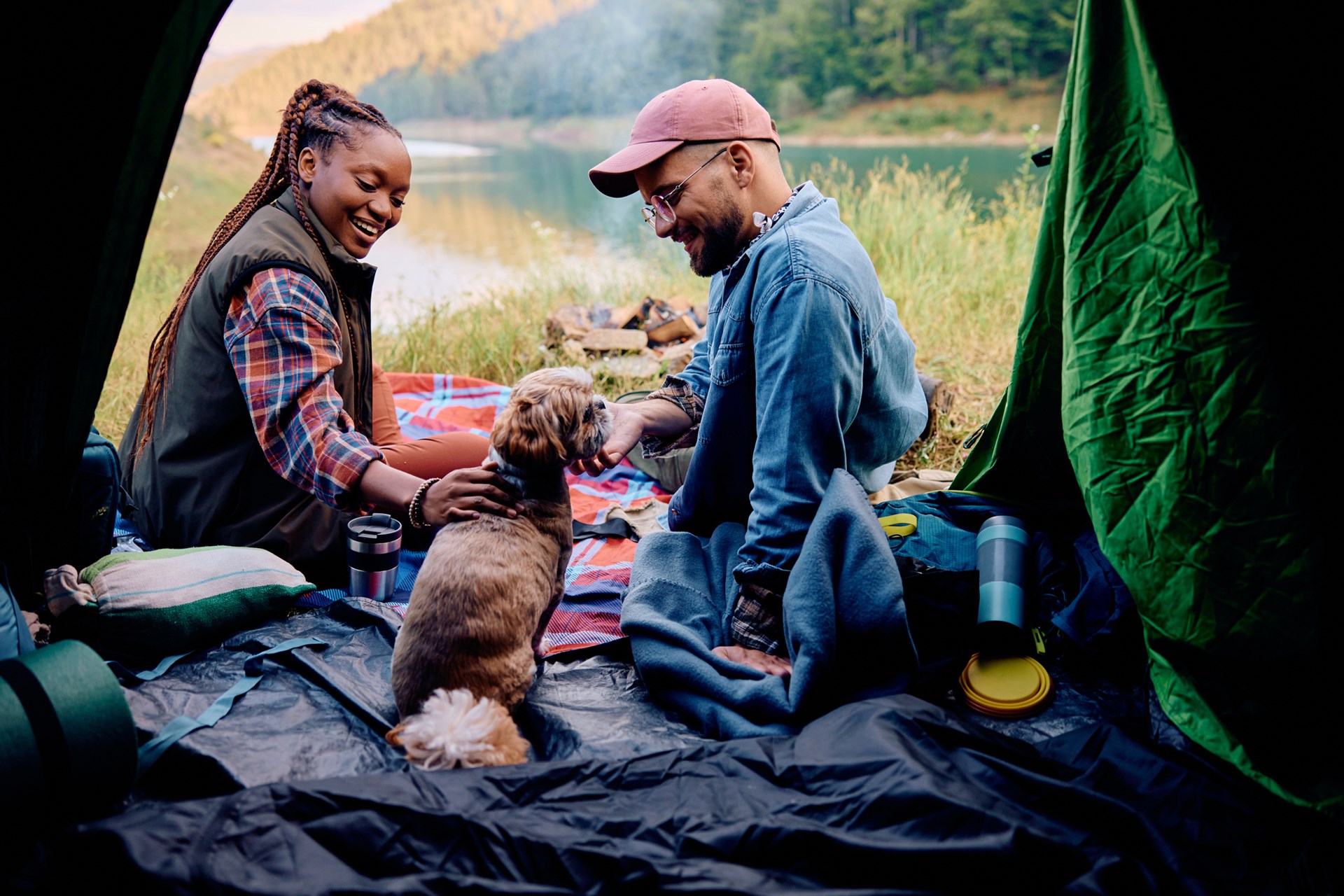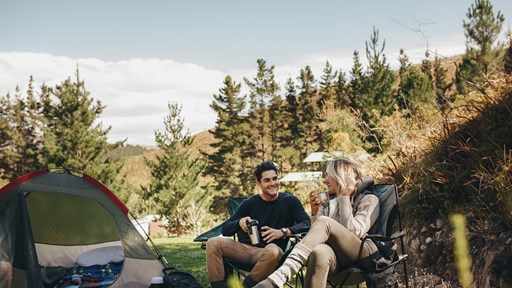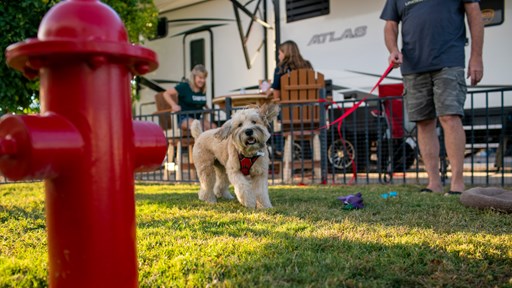If you are like most dog owners, you probably want to bring your four-legged friend along wherever you go — including camping trips. Spending time with your dog can be incredibly beneficial to both of you. By strengthening your bond, you are encouraging your dog to trust you more and introducing them to activities that will keep them healthy and mentally stimulated. In turn, your dog can help you stay more active and develop your social skills. Plus, camping with your dog can be a lot of fun.
Preparing for Your Camping Trip With Your Dog
Your dog will encounter many different environments and situations during your outing, including car rides, other animals, large groups of people and nature. It is crucial that you take time to prepare for every possible circumstance so your dog can have a safe and comfortable trip.
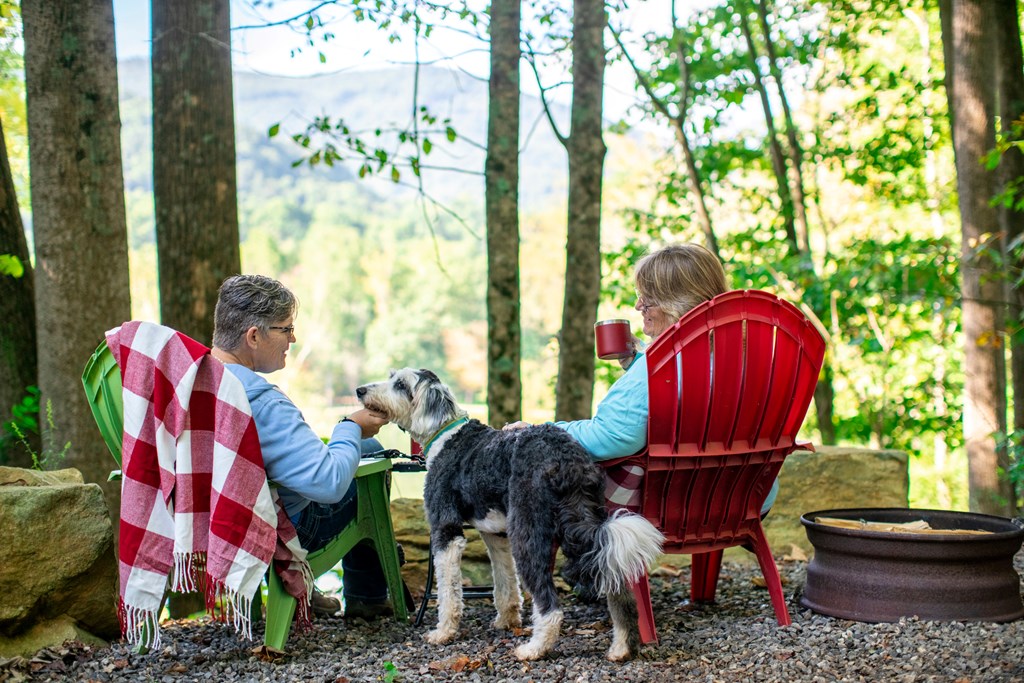
Check Campground Regulations and Guidelines
Although not every campground is pet-friendly, there are many places across the United States that welcome well-behaved dogs. Always contact a campground individually for information regarding their pet policy and rules. Some things to ask about include:
- Leash requirements: Most pet-friendly campgrounds still have leash requirements for the safety of all campers and their pets. Leash requirements vary from location to location, but the general rule is that the leash is no longer than six feet long for easy control. Some places may have additional restrictions, such as no retractable leashes.
- Barking ordinances: All dogs bark, and most campers and campgrounds are very understanding of this. However, if your dog barks uncontrollably or excessively into the night, be aware that some campgrounds may ask you to find lodging elsewhere.
- Aggressive behavior: Pet-friendly campgrounds are a place for pets and their owners to relax safely, which means aggression is not permitted. For the safety of your dog and others, it’s best to leave your pet at home if you feel they might not respond well to other dogs, new people or unfamiliar surroundings.
If you want to keep your dog entertained while camping, search for a campground that has fun, dog-friendly amenities, such as select KOA locations.
Schedule a Vet Appointment
Before you reserve your stay, schedule a check-up appointment for your dog. Make sure your dog is:
- Up-to-date on vaccinations: Your dog should be current on all vaccinations. Most pet parks and campgrounds require your dog to be up-to-date before entry.
- Using some form of flea and tick prevention: The outdoors is an excellent place to have fun with your dog, but be aware that fleas and ticks are common. Talk with your vet about putting your dog on a form of flea and tick prevention.
- Microchipped: Microchipping your dog is not a requirement for campgrounds, but it is recommended. A microchip can help you reunite with your dog if they get loose while camping.
- Groomed: It might seem counterproductive to groom your dog before a camping trip where they are likely to get messy, but it can actually help keep them safer outside. A hair trim can help keep your dog cool in warm temperatures. You should also have your dog’s nails trimmed so they do not get snagged on anything.
- Healthy: If your dog is under the weather or has a chronic illness, camping might not be the best idea. Ask your vet what they think the best plan of action is.
Essentials for Camping With a Dog
In addition to standard camping supplies, camping pet-friendly means bringing along everything your dog needs to have a safe and memorable time. Some dog camping essentials include:
- Dog food and a bowl
- A bowl for water
- Dog treats
- Prescription medication, if applicable
- Stake or tether
- Extra towels
- Dog first-aid kit
- Outdoor-safe toys
- A leash
- A current photo
- Vet records and medical information
- An attachable ID tag
- Dog waste bags
Download Your Dog Camping Essentials Checklist
The following dog camping gear is not necessarily essential, but recommended:
- A dog brush
- An outdoor harness
- A swim-safe leash
- A doggy daypack
- Your dog’s bed
- A dog rain jacket
- Booties or paw protectant
To keep everything organized, consider using a separate bag for your dog’s belongings.

12 Tips for Camping With Your Dog
Before you head out on your camping excursion, take a look at these tips for camping with dogs.
1. Plan Ahead
Although a spontaneous trip with your furry best friend might sound like the dream, planning ahead is the best way to ensure both you and your dog have a safe and enjoyable camping experience. Planning ahead means:
- Checking with the campground about their pet policy and rules.
- Taking your dog to the veterinarian and scheduling a check-up.
- Reserving a campsite early, especially during peak travel times.
- Planning a travel route that includes plenty of pull-off opportunities for your dog to use the bathroom.
- Preparing your dog for interactions with others, including obedience training, if necessary.
- Investing in high-quality gear, including correctly sized harnesses and collars.
2. Take a Picture of Your Dog
Most dog owners have several albums full of dog pictures, but be sure to take one before your camping trip just in case your dog gets loose, and you need help finding them. Make sure the picture is clear and straight on, preferably taken in natural lighting. Be sure to photograph any distinguishing features as well, including unique spots and markings. Print out a copy of the photo and keep it on you while you are camping.
3. Never Leave Your Dog Unattended
Never leave your dog unattended while camping or traveling. This includes in the car, at the campsite, at dog parks and during activities. Keep in mind that just because your dog behaves well around others, other dogs or people might behave unexpectedly. To keep your dog safe and ensure they have a positive experience, make sure you constantly monitor them while playing in any pet areas or at the dog park.
4. Upgrade Your Gear
One of the most helpful camping with dogs hacks is to upgrade your current gear. A standard leash and harness are suitable for your trip, but by implementing a few upgrades, you can help your dog have even more fun. For example, there are dog leashes specifically intended for swimming. They have anti-rust clips and float on the water, making them easier to grab. Reflective harnesses can make it easier for you and others to see your dog in the dark.
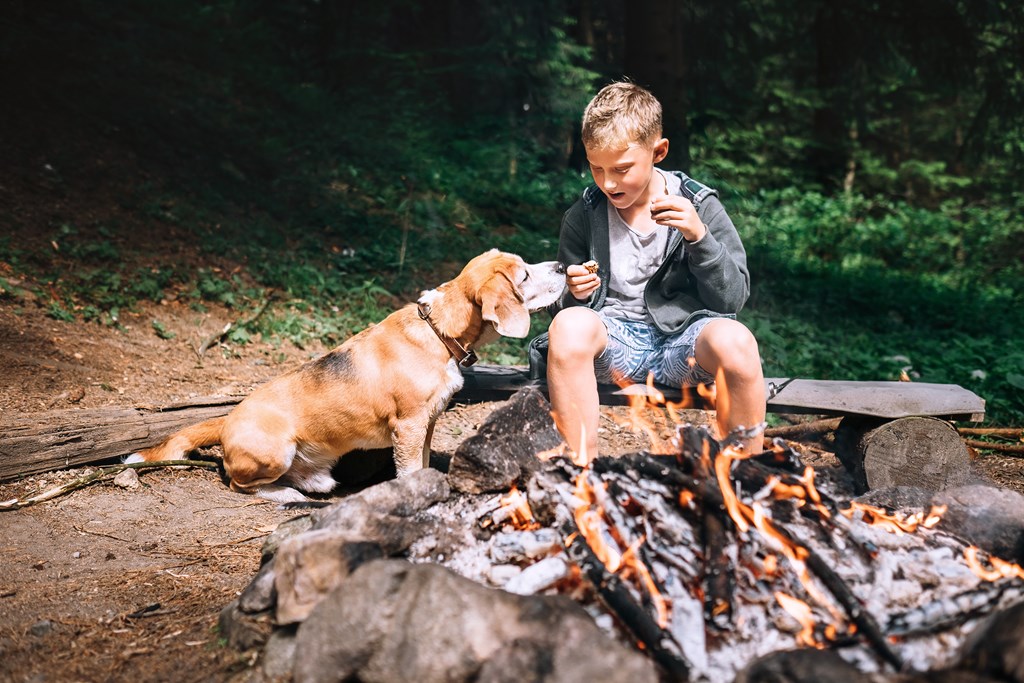
5. Watch out for Allergies
Dogs can feel symptoms of outdoor allergens, just like people can. If your dog is sneezing, itching, wheezing or has a noticeable ear infection, they may be suffering from seasonal allergies. Talk with your vet about treatment options, and do your best to limit your dog’s exposure during high-pollen times.
6. Bring Plenty of Toys
Do not rely on the outdoors being enough stimulation for your dog. Although they will undoubtedly love the chance to roam and play outside, keep in mind that the weather can change quickly, or your dog might get bored. Plan ahead by bringing along some of their favorite outdoor-safe toys, including rope chews, plushies and tennis balls.
7. Provide Extra Hydration
Even if you are not participating in any high-energy activities, being outdoors and in unfamiliar territory means your dog requires more water than usual. You can gauge how much water your dog needs by their weight, activity level and the temperature outside. Adult dogs need about one ounce of water per pound of body weight each day, but your dog requires more outdoors. Use a collapsible water bowl to keep your dog hydrated on the go, and use a large, outdoor-safe bowl at the campsite. Monitor the bowl frequently and remove any dirt or leaves that may infiltrate. To keep the water cool for as long as possible, set it up in a shaded area.
8. Have a Trial Run
If you have never taken your dog camping before or they are new to traveling and the outdoors, consider working your way up. Some ways to prepare your dog for a camping trip include:
- Taking longer walks: A successful campout with your dog depends on your ability to keep your dog safe and under control while at your campsite. You can work on your dog’s on-the-leash behavior by taking it for long walks each day and practicing leash commands.
- Relaxing outside: Is your dog a hermit? Some indoor dogs have little interest in the outdoors, but that does not mean you have to leave them at home when you go on a camping trip. Help them acclimate to the outdoors by spending more time in your yard or on your porch. Take some of their favorite toys outside, or implement a reward system for spending time in the sun.
- Socializing with others: If you are camping at a pet-friendly campground, there will likely be several other dogs and pet owners camping nearby. Practice your dog’s social skills by taking them on a few play dates with other pups. This is also a good way to test your dog’s behavior around others and see if you need to implement any further training.
- Have a backyard campout: If you are unsure how your dog will respond to a camping trip, why not have a trial run? Set up camp in your backyard and behave exactly as you would on a camping trip — keep your dog leashed or secured at all times, spend time around a fire ring and invite your friends or family to join for social interaction. By assessing your dog’s behavior in this controlled environment, you will have a better idea of how to prepare for the real deal.
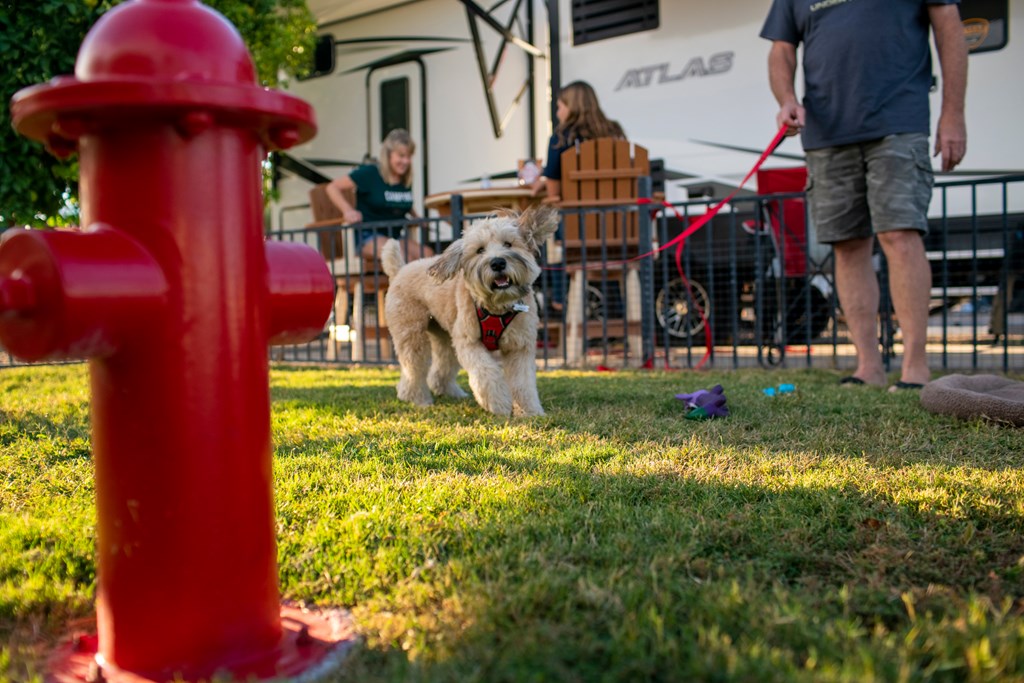
9. Keep Your Dog Secure at All Times
Keep your dog leashed at all times. Most campgrounds have leash requirements, and it is the best way to keep your dog safe. Leashing is especially important when taking your dog for their first walk around the campground. Chances are, they will start to feel a little overwhelmed or excited by all the new sights, sounds and other pets, and a leash is the best way to keep them by your side. This includes keeping your dog leashed while participating in activities, both on-site and away from the campground. A few exceptions include when your dog is sleeping in a secure place overnight, or when staying at a campground with a fenced-in dog park or pet play area, like KOA Paw Pen Sites.
10. Watch out for Wildlife
Other campers and their dogs are not the only interactions you need to be wary of on your camping trip. You also need to be on the lookout for wildlife, including both plants and animals. Be aware of your surroundings when at the campsite and participating in outdoor recreation with your dog. Never let your dog drink from stagnant water and be cautious of lakes, ponds or rivers that could be infected by blue-green algae. Research local plant life and know how to identify a potentially poisonous plant before going for hikes or walks.
11. Plan Dog-Friendly Activities
If you are bringing your dog camping, it is probably because you enjoy spending time together. To make it fun for both of you, incorporate plenty of dog-friendly recreation. Some of the best dog-friendly camping activities include:
- Hitting the trails
- Visiting the beach
- Going boating or kayaking
- Exploring local parks
- Enjoying an outdoor meal
- Playing outdoor games
Remember, not all attractions are dog-friendly. Many state and national parks, beaches, private trails and shopping and dining centers do not allow pets. If you decide to take your dog for a public stroll in a town or city near the campground, always consult local leash laws and bring plenty of dog waste bags.
12. Remember the First-Aid Kit
Never embark on a camping trip without a pet-friendly first-aid kit, especially if you plan to spend a lot of time outdoors. Always carry your dog’s first-aid kit with you while camping, participating in off-site activities and when traveling. Some first-aid kit camping essentials for dogs include:
- Your dog’s vet records
- An up-to-date list of any current medications or recent treatments
- Gauze
- Nonstick bandages
- Adhesive tape
- Pet-safe sterile eyewash
- A digital thermometer
Before you choose your campground, research the nearest emergency vet services. Print, save or screenshot the address, name, phone number and directions.

Dog Safety While Camping
Camping can be beneficial for both you and your dog, but only if you do so safely. Because you are spending time outdoors and in unfamiliar territory, there are a few dog camping tips to keep in mind for a safe and worry-free vacation.
Beware of Overheating
Dogs can get overheated in the sun, just like humans can. Dark-colored dogs or dogs with an abundance of hair will get hot faster than most as well. Combat overheating by keeping your dog in a cool area during the hottest part of the day, and monitoring their behavior while on walks or playing. Always keep cold water accessible.
To prevent overheating, watch your dog closely for the following symptoms:
- Panting
- Heavy breathing
- Restlessness
- Weakness
- Disorientation
- Agitation
- Dry gums
- Bright red tongue
If your dog is experiencing any of these symptoms, use the digital thermometer in your first-aid kit to take a temperature reading. A temperature of 104 or higher indicates overheating. Move your dog to a cool location, preferably in air conditioning or shade. Give them a bowl of cold water. Apply a wrapped icepack to their groin area and continue taking their temperature until they have cooled down. Should symptoms worsen, or if your dog is lethargic, unwilling to move or is having trouble breathing, take them to an emergency veterinarian as this could indicate heat stroke.
Protect Your Dog’s Paws
The pads on your dog’s paws are sensitive to temperatures and abrasive materials, such as:
- Hot pavement
- Salt-melting ice
- Ticks and pests
- Cold and wet ground
- Burrs and sharp rocks
- Broken glass and other debris
To protect your pup’s paws, use a pet-safe or veterinarian-preferred paw protectant or invest in a pair of booties. If your dog has never used any form of paw protectant or shoe, give them plenty of time to acclimate to it at home before going camping.
Make Sure Your Dog Has an ID
In addition to having your dog microchipped at the vet, make sure you have physical ID tags so people know how to get ahold of you should they find your dog. Consider including multiple types of identification, such as a tag on your dog’s collar and ID information inside their harness. You should also add a temporary ID tag that has your campsite number.
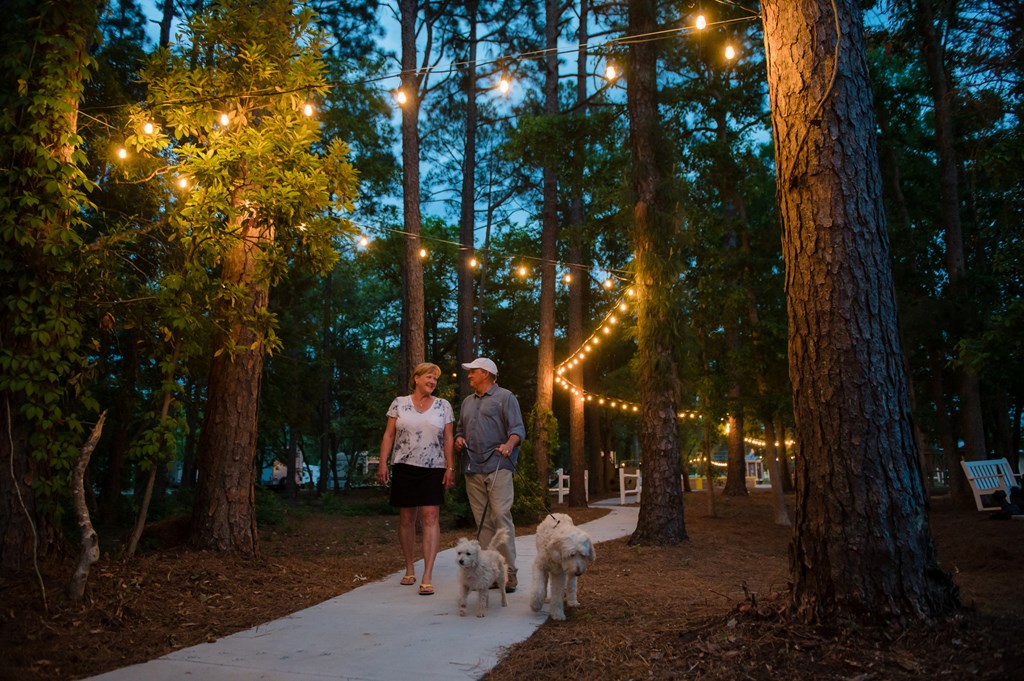
Camping With Dogs: Frequently Asked Questions
If you still have questions about camping with your dog, you have come to the right place! These are some of the most frequently asked questions.
What Do I Do With My Dog While Camping?
In addition to all the fun recreational opportunities listed above, you can use your camping trip to bond and build skills with your dog. Pet-friendly campgrounds are a great place to socialize your dog and meet new friends. While taking walks or participating in activities, brush up on training commands, or teach your dog some new tricks. The most important part of camping with your dog is to spend time together. Traveling and disconnecting from everyday life is the perfect time to bond.
Can Dogs Sleep in Tents?
Tent camping with dogs might be a little more challenging than staying in a cabin or RV, but it is certainly not impossible. When camping with a dog in a tent, keep these factors in mind:
- Tent size: When rooming with a dog, the bigger the tent, the better. Spacious tents will help both of you feel more comfortable and less suffocated, especially on rainy days. This is especially important for medium and large-breed dogs.
- Security: Always zip and secure your tent before going to sleep, so your dog does not escape in the middle of the night. If you are still worried about how your dog will behave, consider placing your luggage and gear in front of the door to block the exit.
- Noise: Some dogs will bark if they hear a sound in the middle of the night. Although it is difficult to noise-proof a tent, you could implement white sound — such as a battery-operated fan — to help calm your dog before bed.
- Sleeping arrangements: To make the transition smooth, try to keep sleeping arrangements as similar to your home routine as possible. For example, if your dog sleeps in a dog bed, bring it along and place it in the tent. If you crate them at night, choose a tent that can accommodate the size of the crate. If they usually sleep with you, do not forget to leave plenty of room on your air mattress or sleeping bag.
Keep in mind that if temperatures are extremely hot or frigid, tent camping with your dog might not be the best idea. Instead, opt for a campground like KOA that offers other lodging opportunities, like Camping Cabin rentals.
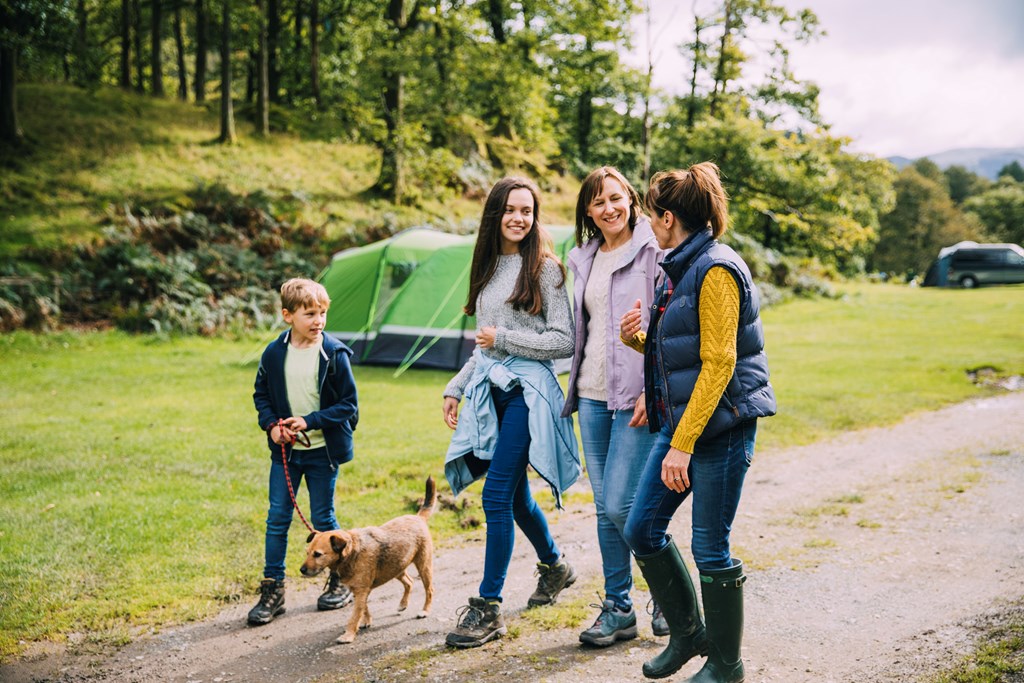
Where Can I Go Camping With My Dog?
Many campgrounds list their pet policy on their websites, but always call individual locations to double-check breed and behavior guidelines. Each hiking trail, beach and national or state park also has its own policies regarding pets, so be sure to check before heading out. Whether it is the mountains, coast or an urban hotspot, as long as you are abiding by all local and campground regulations, you can take your dog camping in many different places.
How Do I Take a Dog Camping in a Car?
For many dogs, car rides are exciting. For others, it can be scary and cause extreme anxiety. If you have never taken your dog on a car ride and plan to do so on the way to a campground, work your way up to it by going for small rides each day. Gradually increase the amount of time your dog spends in the car. Before taking a long trip, make the back seat as comfortable as possible for your dog by laying out blankets and pillows. Bring along their favorite toys and a spill-proof water bowl for mess-free hydration. If you notice your dog getting anxious or restless, find a safe pull-off spot or rest area so they can use the bathroom. You can also use training treats as a form of positive reinforcement.
What If I Am Camping With Multiple Dogs?
Camping with more than one dog is a good way to keep each dog entertained, especially during car rides. Double-check with your chosen campground that there is no pet limit policy in place. You may also want to bring along a friend or family member to make walks and recreation easier.
Make Lasting Memories Camping With Your Dog at KOA
If you are looking for a pet-friendly destination for you and your dog, KOA has you covered. While not every location is pet-friendly, many campgrounds across North America welcome your four-legged friend. Remember, pet policies, restrictions, rules and amenities all vary between campgrounds, so always contact specific locations for the most up-to-date information.
In addition to easy access to nearby attractions, events and activities, many KOA Campgrounds also provide:
- Dog-friendly lodging: Pet-friendly KOA locations have designated dog-friendly sites, perfect for your camping adventure.
Pet wash stations: Select KOA locations have pet wash stations so you can clean your dog after a day of outdoor fun. - KampK9®: Some KOA locations participate in KampK9, which includes shared fenced-in areas for your dog to play, with accessible drinking water and a place for you to sit and watch.
- Paw Pen Sites: Select KOA locations have Paw Pen Sites, which are individual pet-friendly campsites that include a 50-square-foot, gated fence and a shade structure so your dog can enjoy off-the-leash freedom while you relax nearby. Paw Pen Sites also include a doggie bag dispenser and receptacle for easy clean-up.
In addition to these dog-friendly features and amenities, every KOA implements safe speed limits inside the campgrounds and has clean facilities, so you know you and your pet are in good hands. Visit KOA online to reserve your stay today.

About the Author: Kampgrounds of America
Kampgrounds of America is the largest system of open-to-the-public campgrounds in the world, with over 500 locations across the United States and Canada. Founded in Billings, MT in 1962, KOA’s family of campground brands – KOA Journey, KOA Holiday and KOA Resort – today serve more than a million camping families each year. KOA is dedicated to “connecting people to the outdoors and each other” by providing people with a variety of camping experiences and the information they need to make the most of their camping trip. Read more of their camping and travel resources by visiting KOA.com/blog.


















